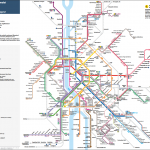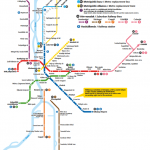General information
The region is in between the former West and East, there is easy access from both sides, and also from other continents. For travel to Budapest there are several good options. The international airport of Budapest (terminals 2A, 2B) connects the city directly to some overseas and to all important European destinations. The three main railway stations (Déli, Keleti, Nyugati) are either terminations or stops of many intercity trains from west and east, south and north. There are several international coach services to Budapest. Motorists can also reach Budapest easily on the European motorway network.
Travel to Budapest by air
There are daily direct flights from most European and from some North American cities. Liszt Ferenc Airport is situated on the SE margin of Budapest, 20 km from the city centre and is a popular destination for many low fare air carriers.
Travel to Budapest by train
Budapest has direct rail links to some 25 capitals. There are three major international railway stations in Budapest:
- Keleti pályaudvar (Eastern Railway Station), on Metro line 2 (“red line”)
- Nyugati pályaudvar (Western Railway Station), on Metro line 3 (“blue line”)
- Déli Pályaudvar (Southern Railway Station), on Metro line 2 (“red line”)
For information on international connections in English see the railway journey planner of the MÁV-Start Zrt. (Hungarian Railway Passenger Transport Co.) or the international railway journey planner Deutsche Bahn.
Public transport in Budapest
Public transport in Budapest is provided by Budapest Transport Ltd. (known to all Hungarians simply as BKK). Budapest has an efficient public transport network. In general the buses, trams and trolleybuses operate between 4.30 AM and 11 PM. All-night bus service operate on the major thoroughfares in the city (night bus timetables are posted at stops and in most metro stations). The three metro lines intersect at Deák Square in the centre of the town. Metros run at 2-15 minutes intervals from about 4.30 AM to 11.15 PM. There are also five suburban railway lines (HÉV) serving the outskirts of the city. For maps, timetables, ticket and pass information etc. see the home page of the BKK Ltd. (Budapest Transport Ltd.)
Public transport (#200E, air conditioned) circulates between the terminals and the Kőbánya-Kispest terminal of the Metro line 3 (“blue line”) at 8-15-minute intervals in daytime. #100E bus cruises between the airport and the Deák Ferenc Square directly to the downtown of the Pest side of Budapest. As an alternative, trains from Terminal 1 leave for Nyugati railway station frequently.
 |
 |
|
Metro, suburban railway and tram network
in Budapest |
Metro and suburban railway lines of Budapest |
If you need more information, please contact the organisers.
Visa and customs information
Customs information for Hungary
Hungary joined the European Union on 1 May 2004. Since that date Hungary has adopted the customs regulation of the European Union. Detailed information about travel documents and customs can be found in this booklet published by the Hungarian Customs and Finance Guard, providing useful information for tourists travelling within the European Union or travelling from a non-community country (third country) to any Member State of the European Union. For further information about the custom procedures, please consult the homepage of the Hungarian customs authority.
Visa information for Hungary
Hungary is part of the Schengen Area of 25 European countries. For non-Schengen EU, USA and Canadian citizens a valid passport is sufficient to enter Hungary. Citizens of other countries should check whether visa is needed for them when entering Hungary (for more information please visit the home page of the Ministry for Foreign Affairs of Hungary). On request, the Organizing Committee will issue invitation letters for visa applications. Please apply in due time for a visa if necessary. Please indicate during the registration if you need a personal invitation to attend the conference. It is important to note that a visa is only a preliminary permission for entry, which does not authorise its bearer automatically to enter the country.